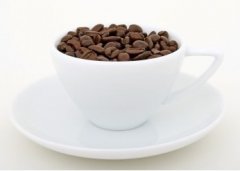Coffee baking at home can bake coffee beans as long as you can read
So much has been said before, in fact, to sum up, it is a simple concept: you can do it, too! Even if you may not be able to find a job in a professional coffee baking test (because the professional roasting test must also take into account the factors of accuracy, stability and quality). But as long as you can understand what is written in this book, you can make good and even amazing baked beans at home. Mr. Jabez Burns (the greatest baking technology developer in American history) once said, "of all the coffee I've ever had, the best cups are made from beans baked in a household popcorn cooker."

Awaken the Spirit of Flavor-- the Chemical change and dramatic Evolution of "Baking"
What happens when coffee beans are "roasted"?
In fact, no one can answer this question very accurately. One of the mysterious characteristics of coffee beans is that their aromatic compounds are very complex. at present, it is known that there are about 700mur850 substances related to flavor in roasted coffee beans. the actual number of substances varies depending on the subject of each experiment and the species of the sample beans, so we can only speculate on the number of substances. It may also have something to do with the geographical conditions of the producing area and the treatment methods of drying and later stage.
Of course, this figure does not include other ingredients that have nothing to do with flavor. About 2000 ingredients have been identified in raw coffee beans of the Arabica species (Coffea Arabica).
This daunting amount of matter makes it natural for Fadu to become the most "complex" thing in daily food and drink. The number of flavor compounds like wine is not as large as that of coffee beans, while vanilla has only about 150 flavor composition positions (this data is provided by professional chemists). Vanilla is also one of the most complex natural condiments. To this day, some "coffee-flavored" food and beverage condiments are extracted directly from roasted beans, rather than by artificial chemical synthesis. This is also due to the "high complexity" characteristics of coffee bean components that are difficult to replicate.
But one thing we can be sure of is that the 700mur850 flavor components in Arabica coffee beans will not show any "fragrance" if they are not "baked". Therefore, "baking" is a necessary action to awaken the spirit of coffee and raw bean flavor.
Rough denial says that "baking" has the following purposes:
1. Take the excess water out of the coffee beans.
two。 The coffee beans are dried and the xylem is expanded, so that the coffee beans can have more vents and the total weight of the coffee beans is reduced by 14% and 20%.
3. Start a continuous process of converting sugar into carbon dioxide gas, which does not stop immediately after baking and continues until the coffee beans are stale.
4. Take away some volatile substances, and a small portion of caffeine will also be taken away.
5. Some of the sugars in coffee beans are converted into caramel, and some of the ingredients are converted into substances that we become "flavor oils". Flavor oils are very small units and easily destroyed, but the ingredients that make up this compound do not look so delicious, such as aldehydes (Aldehydes), ketones (Ketones), lipids (Esters), Acetic Acid (acetic acid), Butyric Acid (butyric acid), (Caleric Acid) and so on.
Coffee is actually made up of caramelized sugar, combined with flavor oils and other components (such as bitter factor Trigonelline, quinic acid and nicotinic acid, etc.), plus about 1% caffeine, a drink that is so complex and mysterious that drinkers all over the world are so happy to drink.
Some of the ingredients of roasted coffee beans are converted into protective caramelized sugar and flavor oils, which are hidden in the loose pores of xylem (if in more deeply roasted coffee beans, some of the flavor oils are forced to be brought to the surface of the coffee beans, making the appearance of the deep-roasted coffee beans always look oily). Carbon dioxide is also emitted from the inside of the coffee beans, a process called "Degassing", which helps protect flavor oils from oxidation (of course, when carbon dioxide emissions stop, flavor oils are quickly oxidized and stale). Vacuum cans, nitrogen-filled bags and so on are artificial preservation containers to protect coffee bean flavor oil from oxidation. When the naturally formed protective measures of coffee beans fail because of grinding, the carbon dioxide gas will dissipate more quickly!
Important Notice :
前街咖啡 FrontStreet Coffee has moved to new addredd:
FrontStreet Coffee Address: 315,Donghua East Road,GuangZhou
Tel:020 38364473
- Prev

Reasons for roasting coffee beans by roasting yourself
So for those of us who didn't smell the aroma of roasted coffee beans when we were young, or those of us who lived in newly developed areas of the western United States and remembered only Pepsi and Maxwell instant coffee, what's the reason to bake coffee beans at home? Baking your own coffee beans is a simple thing, but it is also a forgotten art. Then why are we still here?
- Next

The dramatic evolution of the stages of coffee roasting
What I just mentioned is something that happens inside the coffee beans, so what will happen in the appearance? A few minutes before the coffee beans are heated in the baking room, we don't see much change in appearance, when the coffee beans are still grayish green and there is no sound. After a while, the appearance of coffee beans will gradually turn yellow and emit similar colors.
Related
- Beginners will see the "Coffee pull flower" guide!
- What is the difference between ice blog purified milk and ordinary milk coffee?
- Why is the Philippines the largest producer of crops in Liberia?
- For coffee extraction, should the fine powder be retained?
- How does extracted espresso fill pressed powder? How much strength does it take to press the powder?
- How to make jasmine cold extract coffee? Is the jasmine + latte good?
- Will this little toy really make the coffee taste better? How does Lily Drip affect coffee extraction?
- Will the action of slapping the filter cup also affect coffee extraction?
- What's the difference between powder-to-water ratio and powder-to-liquid ratio?
- What is the Ethiopian local species? What does it have to do with Heirloom native species?

